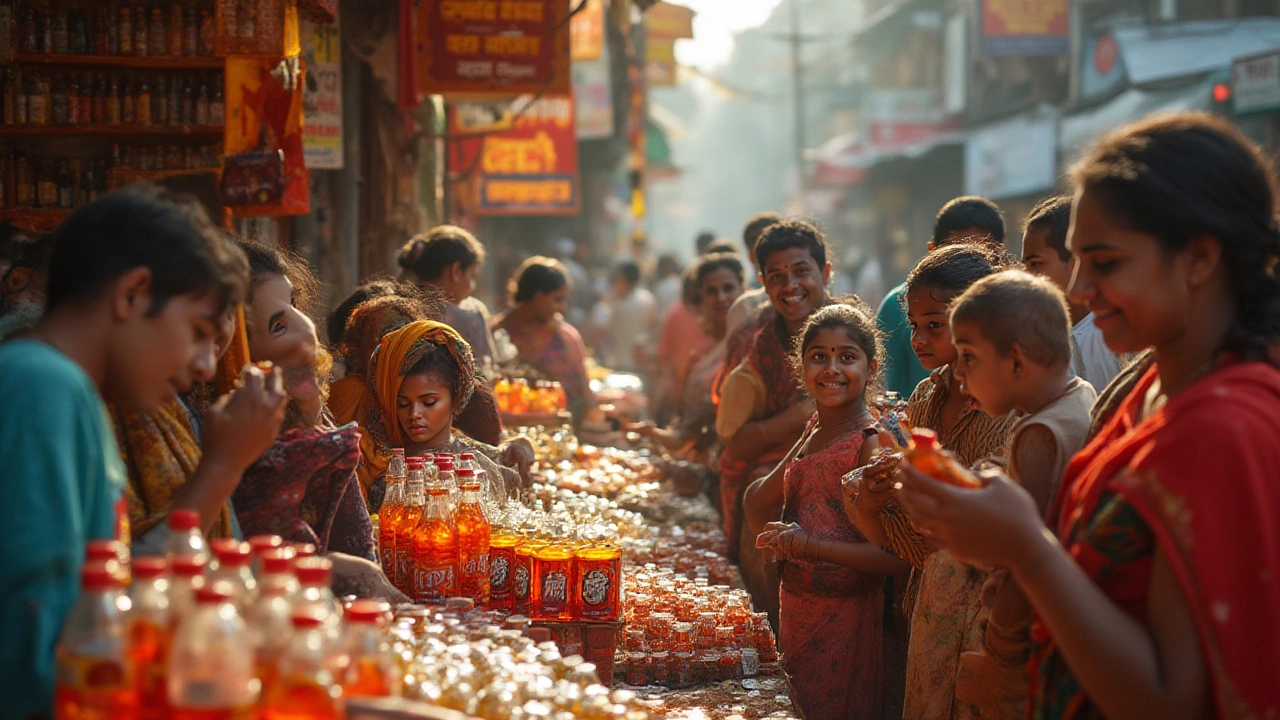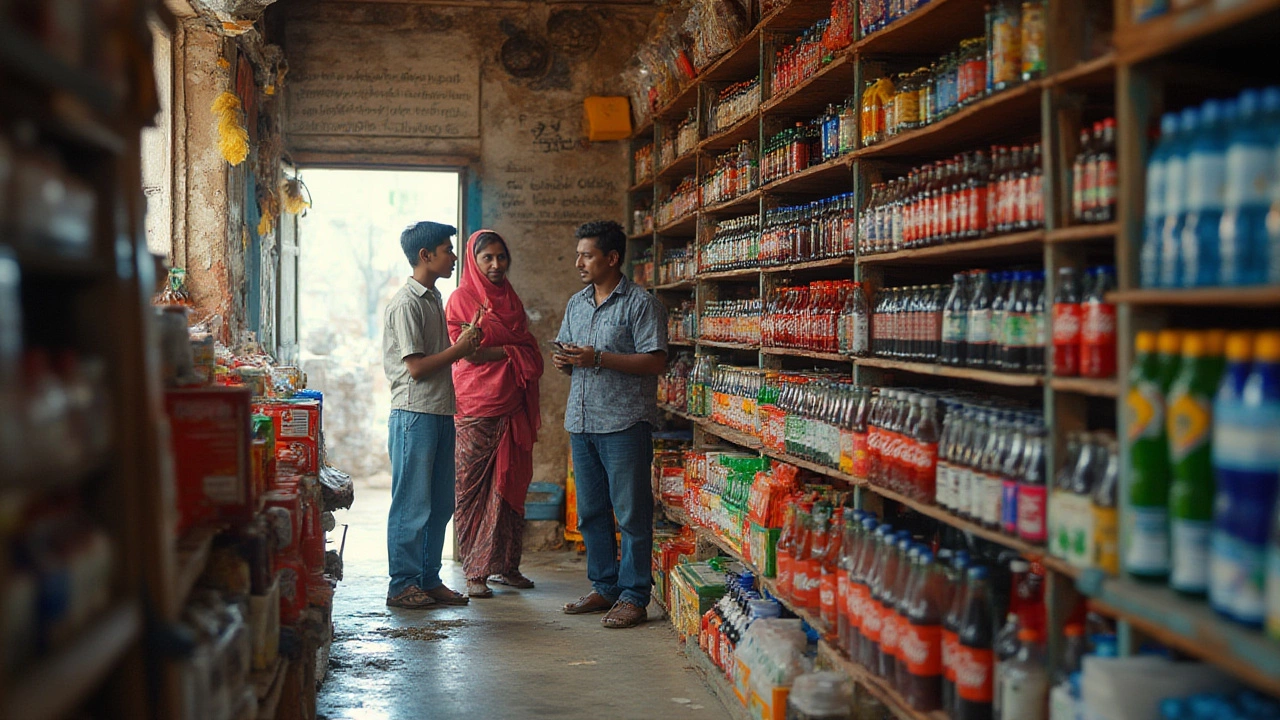Coke Price in India: 2025 Guide to Coca-Cola Costs, Sizes, and Tips
 Jul, 5 2025
Jul, 5 2025
Pop open a cold Coke in Mumbai or Delhi and you might raise your eyebrows—because the price tag can swing hard depending on where you’re standing. Grabbing a soft drink in India isn’t like buying a can at your neighborhood store back home. The local climate, massive crowds, diverse retailers, and even festivals all play a part in what you’ll pay for a Coke. I still remember my first trip to India: we landed in Bengaluru totally jetlagged, and the first thing I did was ask a street vendor for a bottle of Coke. The flavor felt familiar, but the price was not what I expected. Since then, I’ve kept tabs on where, when, and how much you gotta fork out for your fizz fix.
Understanding Coke Pricing: City to City, Street to Street
Ask someone “How much is a Coke in India?” and you might get four different answers in a single mile of travel. Prices can be totally different depending on the city, whether you’re at a high-end mall, the airport, a tiny street stall, or a roadside dhaba. In 2025, the most common bottle you’ll see is the 250 ml or 300 ml PET bottle, followed by cans (330 ml), then the classic glass returnable bottles—though the glass bottles are getting a bit rarer. On average, as of July 2025, a 250 ml Coke costs around ₹20-₹30 ($0.24-$0.36 USD). Larger 500 ml PET bottles run between ₹35-₹45 ($0.42-$0.54), while a 330 ml can sits at ₹40-₹50 ($0.48-$0.60). But, here’s the kicker—if you get one at a highway rest stop during peak tourist season—or at certain movie theaters or airports—you could pay double. On the flipside, the good ol’ neighborhood grocery store, or a local Kirana shop, will usually stick close to the official MRP (Maximum Retail Price), the government-mandated maximum cost per bottle, which you’ll find stamped on every package. The guy selling cold drinks near the Taj Mahal? He’s conveniently ignoring the MRP, especially during the hot season or public holidays.
Don’t be surprised if rural areas see slightly different prices and, occasionally, bigger or smaller bottles (like a 200 ml mini for ₹15, or huge 2-liter bottles for ₹85 to ₹100). Locals know their market, and so do the sellers—they’re quick to hike prices when tourists show up, or drop them during off-peak times to clear stock before the drinks go flat. There’s also heavy brand competition from Pepsi, Thums Up (which is actually owned by Coca-Cola), and local drinks, so prices can sometimes change to match rivals—especially during events like IPL cricket games, Diwali, and summer break run-ups.
Bottle Sizes, Packaging, and the Taste Debate
Walk into any Indian grocery or roadside shack and your options won’t stop at “just Coke.” There’s regular Coke, Diet Coke, Coke Zero Sugar, and, if you’re lucky, special limited-edition flavors. Coke bottles here look just a touch different from Western ones. The 250 ml PET bottle is perfect for sipping on a rickshaw—easy to stash in a bag, easy to cool. But purists (like me) miss those reusable glass bottles. These 200-ml or 300-ml glass bottles are chilled in ice coolers, sometimes so cold the label peels off. To drink it, they pop off the metal cap with a bottle opener, and the fizz hits your throat way better. Returning the bottle gets you a small deposit back—sellers love these because they taste better, stay cold longer, and cost less to restock.
Here’s something interesting: Indian Coke is made with a different sugar—often cane sugar instead of high-fructose corn syrup found in most US Cokes. Trust me, you’ll notice a slight difference. Locals even swear by the “Indian formula” for being sweeter and having a sharper fizz. If you’re a Diet Coke or Coke Zero fan, you’ll mostly find these in big cities or mid-size supermarkets; tiny corner stores may stick with classic red-label Coke, Fanta, and Thums Up. During festivals or regional sports matches, you might see combo deals—buy two Cokes and get a discount on chips, or collect bottle caps for prizes.
Packaging varies too. Cans show up mostly in urban centers, chain restaurants like McDonald’s or KFC, multiplex cinemas, and airports—where convenience trumps everything. Soft drink cans cost more per milliliter, but if you’re traveling and need a cold drink, and fast, sometimes they’re worth the splurge.

Where to Buy and How to Get the Best Deal
India loves its street culture. If you want the most authentic—and often cheapest—Coke, just head to the local Kirana store (the ubiquitous, family-run mini-markets found on almost every street), or even a roadside drink cart. They chill their drinks in metal tubs full of ice water, stacked with Coke bottles, Fanta, and the occasional Sprite. Most Kirana shops sell Coke for exactly the labeled MRP. If you’re not sure, just ask, "Kitna hua?" (How much is it?). Vendors in tourist-heavy areas or near landmarks like the Gateway of India, Jaipur’s City Palace, or the beaches of Goa tack on an extra ₹5-₹10, especially if you look like you’re only visiting.
One pro tip: Always check the MRP label. In India, it’s legally required to print the maximum price (including all taxes) right on the bottle or can. If someone tries to charge you more, especially in smaller cities, you can point to the label and insist. This trick saved me a handful of rupees in Varanasi, each time I showed the MRP to the friendly (but hustling) vendor. At transport hubs—big railway stations and airports—prices skyrocket. If you can, grab a Coke before you head to the train or plane. Chain supermarkets and convenience stores like Big Bazaar, Reliance Fresh, and 24 Seven might run special offers, especially for bigger 1-liter or 2-liter bottles. Look for multi-bottle packs—they’re popular with families and cheaper per milliliter.
Online grocery shopping is another hack if you’re staying a while. Apps like Blinkit, Zepto, and BigBasket all sell Coke (in every size) and can drop drinks at your hotel or AirBnb’s doorstep within 15 minutes, often cheaper thanks to e-coupons. During India’s steamy summers (May-June), sellers sometimes offer flash discounts just to clear their fridges before stock expires or loses fizz.
Surprising Coke Culture: Festivals, Trends, and Local Tips
India’s relationship with Coke is big business. The country is one of Coca-Cola’s top five global markets by volume, and the company has built some massive bottling plants in places like Uttar Pradesh and West Bengal. You’ll even see Coke ads painted on sides of buildings in villages, or hear regional pop stars belting out jingles on the radio. But Coke isn’t just a city drink, or a symbol of modernity. In rural areas, it’s still a treat, reserved for special days—weddings, birthdays, cricket tournaments, or the last day of school before summer break. My wife Maya’s cousins in Kerala, for example, always buy the big 2-liter bottle and split it into steel cups mixed with homemade lemon or sliced ginger for family parties.
Don’t be fooled into thinking Coke is identical across India, either. In southern states, it sometimes plays second-fiddle to local sodas like Bovonto, Limca, or Bovonto, which nudge Coke to compete with seasonal discounts or combo packs—especially during Onam, Durga Puja, Diwali, or Ganesh Chaturthi. On the flip side, during Ramadan or the summer Iftar fasts, chilled Coke bottles sell like crazy in evening markets. At major events, you’ll spot Coke contests: keep an eye out for "Find the Golden Cap" or "Scan the QR code for cashback" deals. It’s not just marketing talk—lots of locals collect points for free drinks or even cricket match tickets.
One thing every traveler learns: always drink your Coke cold, never with ice from street stalls unless you’re certain it’s clean. Indian summers get brutal—40°C (104°F) is the norm in many places. Nothing hits like an ice-cold Coke fresh from a glass bottle on a roasting June day in Rajasthan.
If you’re watching your sugar, don’t get your hopes up for fancy sugar-free or niche limited-edition flavors in smaller towns. Those tend to stick around big metros like Mumbai, Chennai, or Bangalore. If you’re a die-hard collector, keep an eye on special edition bottles—like regional festival labels, local cricket team logos, or tie-ins with Indian musical acts. They sometimes appear during major holidays, but they disappear fast.
No matter where you roam in India, Coke is often the drink that brings everyone together—across village weddings, posh offices, and gritty city stations. And yeah, the price will swing, the flavor will maybe taste a touch sweeter, and the deals will be everywhere if you know where to look. But for that moment, bottle in hand, the taste of a cold Coke on the hottest day feels a lot like home—wherever yours may be.